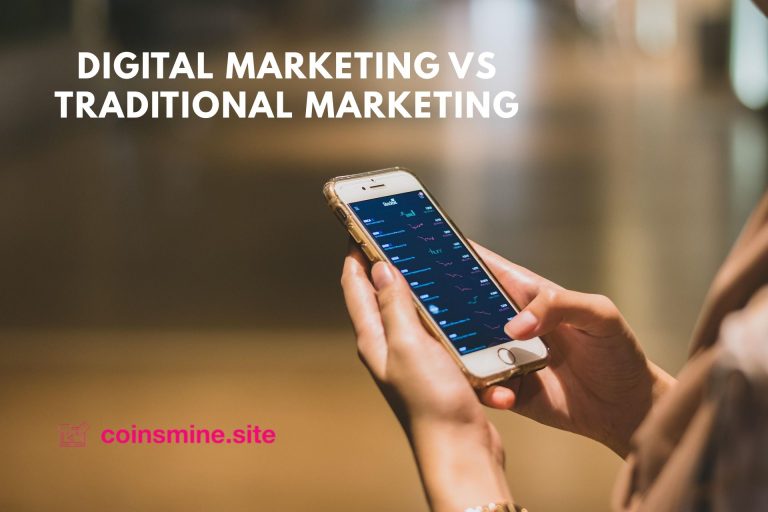Digital Marketing vs Traditional Marketing: Digital marketing and traditional marketing are two distinct approaches to promoting products and services. Traditional marketing includes channels like TV, radio, print ads, and billboards, often targeting broad audiences with limited tracking capabilities. In contrast, digital marketing uses online platforms such as social media, email, and search engines, offering precise audience targeting, real-time engagement, and measurable results.
Digital marketing is more cost-effective and data-driven, but traditional approaches are still useful for brand awareness and local outreach. Ultimately, the best strategy often involves combining both approaches to reach diverse audiences and maximize marketing impact.
Digital Marketing vs. Traditional Marketing: What’s the Difference, and Which One Works Best?
Marketing is essential for any business looking to build brand awareness, attract customers, and drive sales. Over the years, marketing strategies have evolved dramatically, giving rise to two major approaches: traditional marketing and digital marketing. While both aim to reach and influence potential customers, they do so in very different ways. Understanding their differences, benefits, and limitations can help businesses make smarter decisions about how to allocate their marketing budget.
What is traditional marketing?
The customary techniques employed before the emergence of the Internet are referred to as traditional marketing. This includes:
-
Television and radio ads
-
Print ads in newspapers and magazines
-
Billboards and outdoor signage
-
Flyers, brochures, and direct mail
-
Telemarketing and word-of-mouth
Traditional marketing has been around for decades and is still effective in certain industries and demographics.
What is digital marketing?
Digital marketing uses online platforms and digital technologies to promote products or services. It includes:
-
Social media marketing (Facebook, Instagram, LinkedIn, TikTok)
-
Search engine optimization (SEO)
-
Pay-per-click advertising (Google Ads, social ads)
-
Email marketing
-
Content marketing (blogs, videos, infographics)
-
Affiliate and influencer marketing
Digital marketing is more interactive and allows businesses to target specific audiences with tailored messages and real-time feedback.
Key Differences Between Digital and Traditional Marketing
(1) Reach and Targeting.
-
Traditional marketing casts a wide net and is ideal for reaching local or regional audiences. However, targeting is limited—you can’t control exactly who sees your billboard or hears your radio ad.
-
Digital marketing, you can segment your audience by demographics, interests, behavior, and location, ensuring your message reaches the right people.
(2) Cost Efficiency.
-
Traditional methods are usually more expensive. TV ads, print media, and billboard campaigns often require a high upfront investment with no guaranteed return.
-
Digital marketing is generally more affordable and scalable. Small businesses can run social media or email campaigns on limited budgets while still achieving measurable results.
(3) Measurability and Analytics.
-
With traditional marketing, it’s hard to track effectiveness. For example, you can’t easily measure how many people saw your newspaper ad or acted on it.
-
Digital marketing provides detailed analytics. You can track impressions, clicks, conversions, and customer behavior in real time, making it easier to adjust and improve your strategy.
(4) Engagement and Interaction.
-
Traditional marketing is one-way communication. The business sends a message, but there’s no easy way for consumers to respond or engage.
-
Digital marketing is interactive. Audiences can like, comment, share, or message directly. This fosters engagement, builds relationships, and increases trust.
(5) Flexibility and Speed.
-
Once a traditional campaign is launched, changes are difficult and expensive. If there’s a mistake in a printed ad, it can’t be edited.
-
Digital campaigns can be adjusted instantly. You can pause ads, update content, or shift strategy in response to performance data or market trends.
Which One Is Better?
There’s no one-size-fits-all answer. Your industry, audience, budget, and business objectives will all influence the best option.
-
Traditional marketing may be more effective for reaching older demographics or for brand visibility in specific locations (e.g., local TV or outdoor ads).
-
Digital marketing is typically more suitable for younger audiences, online businesses, and brands that need to scale quickly or operate with tight budgets.
In many cases, a hybrid approach works best. For example, a retail store might use radio ads for local reach and digital campaigns to drive e-commerce traffic.
Conclusion.
Both traditional and digital marketing have their strengths and limitations. While digital marketing offers better targeting, engagement, and tracking, traditional marketing still holds value for broad audience exposure and brand recognition. The most successful businesses understand how to leverage the strengths of each method to create a balanced and effective marketing strategy.



